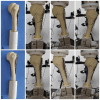Biomechanical study of two different fixation methods for the treatment of Neer III proximal humerus fractures
- PMID: 39725904
- PMCID: PMC11670373
- DOI: 10.1186/s12891-024-08216-0
Biomechanical study of two different fixation methods for the treatment of Neer III proximal humerus fractures
Abstract
Background: The lateral locking plate for the proximal humerus is currently the most commonly used surgical procedure for the treatment of elderly proximal humeral comminuted fractures. Previous studies have found that the rate of postoperative complications in patients of proximal humerus fractures with medial column involvement is relatively high. Through biomechanical methods, this study aims to investigate the effectiveness of the conventional lateral locking plate fixation along with the addition of the metacarpal supporting plate on the medial column in the treatment for proximal humeral fractures involving the medial column. The goal is to reduce the rate of postoperative internal fixation failure in patients with medial column injury.
Methods: Thirty artificial synthetic humerus models are used as experimental samples. A proximal humerus fracture model with medial column injury was created, and then divided into two groups. Group A was fixed with a proximal humerus lateral locking plate (single-plate group). Group B was fixed with a proximal humerus lateral locking plate and a metacarpal supporting plate on the medial column (double-plate group). The failure displacement, stiffness, and strength of the repaired proximal humerus fractures with two different methods were tested under compression at posterior extension of 15°, forward flexion of 15°, and vertical direction.
Results: There was no statistical significance in the comparison of the failure displacement of repaired proximal humeral fractures between the two groups under compression at posterior extension of 15° and forward flexion of 15° (P > 0.05). However, the failure displacement of the fracture was longer in single-plate group than in double-plate group under compression at vertical direction (P < 0.05). The double-plate group was better in terms of biomechanical stiffness and strength compared to the single-plate group at all three testing angles (P < 0.05).
Conclusions: For patients whose proximal humeral fractures involve the medial column, the addition of a support plate on the medial side of the humerus is recommended along with the lateral locking plate. The double-plate strategy can increase the stability of the medial column of the proximal humerus, and enhance the overall biomechanical property of the repaired proximal humerus.
Keywords: Biomechanical property; Lateral locking plate; Metacarpal supporting plate; Proximal humeral fractures.
© 2024. The Author(s).
Conflict of interest statement
Declarations. Ethics approval and consent to participate: This study was approved by the Institutional Review Board (IRB) of Jinshan District Central Hospital (No. jszxyy202120). No human tissue or specimen were involved in this study. There was no human participant in this study. Artificial bone models were applied for all the experiments. Consent for publication: Not applicable. Competing interests: The authors declare no competing interests.
Figures

Similar articles
-
A novel surgical approach and technique and short-term clinical efficacy for the treatment of proximal humerus fractures with the combined use of medial anatomical locking plate fixation and minimally invasive lateral locking plate fixation.J Orthop Surg Res. 2021 Jan 9;16(1):29. doi: 10.1186/s13018-020-02094-7. J Orthop Surg Res. 2021. PMID: 33422119 Free PMC article.
-
Biomechanical behavior of three types of fixation in the two-part proximal humerus fracture without medial cortical support.PLoS One. 2019 Jul 30;14(7):e0220523. doi: 10.1371/journal.pone.0220523. eCollection 2019. PLoS One. 2019. PMID: 31361778 Free PMC article.
-
The mechanical benefit of medial support screws in locking plating of proximal humerus fractures.PLoS One. 2014 Aug 1;9(8):e103297. doi: 10.1371/journal.pone.0103297. eCollection 2014. PLoS One. 2014. PMID: 25084520 Free PMC article.
-
How to enhance the stability of locking plate fixation of proximal humerus fractures? An overview of current biomechanical and clinical data.Injury. 2015 Jul;46(7):1207-14. doi: 10.1016/j.injury.2015.04.020. Epub 2015 Apr 24. Injury. 2015. PMID: 25978864 Review.
-
[Progress in the research of medial column reconstruction of proximal humerus fractures in the elderly].Zhongguo Gu Shang. 2022 Mar 25;35(3):300-4. doi: 10.12200/j.issn.1003-0034.2022.03.019. Zhongguo Gu Shang. 2022. PMID: 35322624 Review. Chinese.
References
-
- Leino O, Lehtimaki K, Makela K, et al. Proximal humeral fractures in Finland: trends in the incidence and methods of treatment between 1997 and 2019. Bone Joint J. 2022;104–B(1):150–6. - PubMed
-
- Min K, Sherisan B, Waryasz G, et al. Predicting reoperation after operative treatment of proximal humerus fractures. Eur J Orthop Surg Traumatol. 2021;31(6):1105–12. - PubMed
-
- Varga P, Inzana J, Fletcher J, et al. Cement augmentation of calcar screws may provide the greatest reduction in predicted screw cut out risk for proximal humerus plating based on validated parametric computational modelling: augmenting proximal humerus fracture plating. Bone Joint Res. 2020;9(9):534–42. - PMC - PubMed
-
- Boesmueller S, Wech M, Gregori M, et al. Risk factors for humeral head necrosis and non-union after plating in proximal humeral fractures. Injury. 2016;47(2):350–5. - PubMed
Publication types
MeSH terms
Grants and funding
LinkOut - more resources
Full Text Sources
Medical

